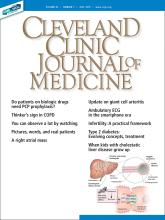An 88-year-old woman with chronic respiratory failure and on long-term oxygen therapy for chronic obstructive pulmonary disease (COPD) was admitted with increasing dyspnea. Physical examination revealed areas of hyperpigmentation and skin thickening on the distal third of both thighs (Figure 1). These alterations were characterized as elongated and hyperkeratotic.
Hyperpigmented, thickened skin on both thighs.
See related editorials, page 440 and page 443
The patient had been repeatedly hospitalized for episodes of acute dyspnea aggravated by emotional distress and was instructed to relieve her symptoms by using pursed-lip breathing and the tripod position— ie, sitting down and leaning forward with the forearms resting on the thighs (Figure 2). This position can increase activity of accessory respiratory muscles during inspiration, which may relieve symptoms of dyspnea.
The tripod position to relieve dyspnea results in direct mechanical pressure of the elbows on the top of the thighs.
Mechanical pressure induced by friction of the elbows on the thighs may result in proliferation of the stratum corneum and the release of hemosiderin from erythrocytes, resulting in the skin changes seen in this patient, which because of the tripod positioning are known as “thinker’s sign,” a term coined in 1963 by Rothenberg1 to describe findings in patients with chronic pulmonary disease and advanced respiratory insufficiency. It is also referred to as the Dahl sign, based on a report by Dahl of similar findings in patients with emphysema.2
- Copyright © 2019 The Cleveland Clinic Foundation. All Rights Reserved.








